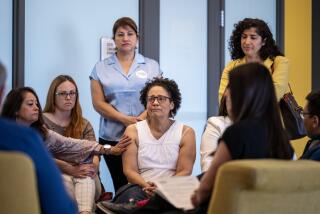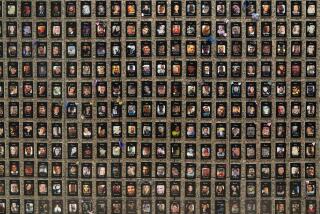The Special Needs of Women and Children With AIDS
- Share via
NEW YORK — She is a young, well-educated Haitian living in Miami. She once held a good job, was a member of her community and was raising her young daughter within a warm, loving family.
Today, she has no job, her family has resoundingly abandoned her, she bounces from social service group to social service group for assistance finding food, shelter and medicine. She is depressed and anxious and refuses to care for herself. Her whole concentration remains on her daughter. Both have AIDS.
“If anything happens to me, what will happen to my baby?” she said. “I just want to be here for my daughter for as long as I can.” When asked how she felt when she saw her daughter, she responded, “I just keep looking at her and wondering if she’s going to make it.”
The psychologist who shared this case study during the 95th meeting of the American Psychological Assn. last weekend also related the harsh reality: Neither mother nor child will probably live.
From the professionals who gathered here to share their research and their data, their successes and failures with AIDS victims, particularly women and children, came even grimmer statistics:
No. 1 in New York
Women comprised 7% of all AIDS reported cases since 1981, when the Centers for Disease Control began recording data on the illness. In New York, acquired immune deficiency syndrome is now the No. 1 killer for women aged 25-29.
Perinatal transmission of AIDS from mother to child accounts for 80% of all pediatric cases, and those cases are concentrated in three primary regions: the Northeast around New York and Newark, N.J., the South in the Miami area and the Southwest around Los Angeles.
In addition, pediatric AIDS cases, while only 1% of the total AIDS cases in the country, are expected to increase substantially as the virus is spread to more women of child-bearing age through heterosexual contact and i.v. drug use. The Public Health Service estimates that 3,000 children will contract AIDS in the United States by 1991.
The psychologists gathered here repeatedly expressed concerned for the fate of these women and children, because the resources that help mitigate the complicated problems of AIDS are already strapped. A call for further research and better coordination of services and education echoed throughout the numerous symposiums and discussions.
“Putting together a child development program for a multiproblem family is comparable to developing a nutrition program for a family that doesn’t have any food in the refrigerator,” Woodruff said.
The mini-convention on AIDS provided a chance for people who are treating women and children with AIDS to compare notes and pool resources. They found similar patterns throughout the country:
Unlike gay men who have banded for support, women and children with AIDS often face rejection from their families and communities. Isolated and sick, they must worry about where they will sleep and how they will eat.
Mothers feel the guilt of passing the illness to their children, although that often doesn’t stop them from having additional children. They face attitudinal and cultural barriers, the stigma in some cases of being a drug addict, with the added perception that they have abandoned their responsibilities as mothers.
Their emotional problems are compounded by the physical and neurological problems that the disease causes.
“AIDS is far more grave and devastating than any cancer we know of,” said William Redd, who has worked with cancer patients at Memorial Sloan Kettering Memorial Cancer Center in New York and is now handling AIDS patients. “Not only are we dealing with the grief and bereavement of a terminal illness, but we have cognitive impairment and the incredible stigma that is attached to the disease.”
At the same time, child welfare agencies are already overburdened with record caseloads of abused, neglected or mistreated children in poverty, according to Vivian T. Shayne, director of research for the professional development group at the Rockefeller College of Public Affairs and Policy in Albany, N.Y.
Available Resources
“In New York, the supply of available resources is greatly exceeded by the demands of children with AIDS,” Shayne said “Convoluted administrative procedures and bureaucratic sluggishness have blocked these children from timely access to appropriate assistance.”
Consequently, caseworkers can do little more than investigate the family and try to gain access to resources for the AIDS sufferers, the psychologists say, and do not have the time to counsel women who are dealing with the diagnosis of a terminal illness.
Cost is an additional burden. Shayne states that the average required to pay for a child with AIDS is $86,000 compared with $55,000 for one adult case. Hospitals are unable to assume this burden; day care and foster care is difficult to obtain because no one wants the risk of caring for these children.
In fact, one of the biggest problems surrounding the problem of children with AIDS is finding foster care and day care. Children with AIDS are not unlike other terminally or chronically ill youngsters who must endure pain, fear and isolation. But the psychologists point out that the psychosocial impact of their illness is even more devastating because so many of these children are abandoned because of the illness.
Various Members
Psychologists have found that programs like WIN--a community-based Boston program that coordinates agencies providing aid for intravenous drug using families and children younger than 5 in Boston--could help coordinate the different agencies that are servicing these AIDS patients by having various members of each group meet on a weekly basis and share their information.
Since i.v. drug users cannot be relied upon to keep a routine, a mother and child with AIDS are commonly seen by different doctors and health care professionals throughout an area. By coordinating the agencies that are helping a woman find housing, food, health and emotional care, WIN has eliminated much of the overlap and duplication of efforts, which means the programs are more cost-efficient.
The U.S. Surgeon General’s office issued a similar recommendation this spring for coordination on a federal level, not just for AIDS, but also for the special handicapped needs that AIDS causes by delaying development in children, according to Jeffrey M. Seibert, associate professor at the Mailman Center for Child Development at the University of Miami.
More to Read
Sign up for Essential California
The most important California stories and recommendations in your inbox every morning.
You may occasionally receive promotional content from the Los Angeles Times.










